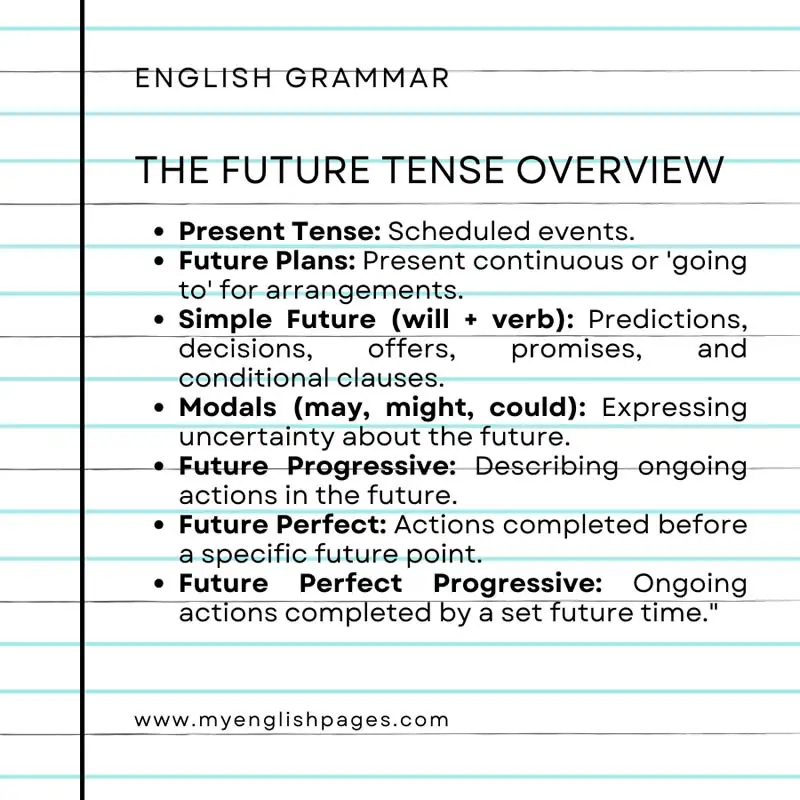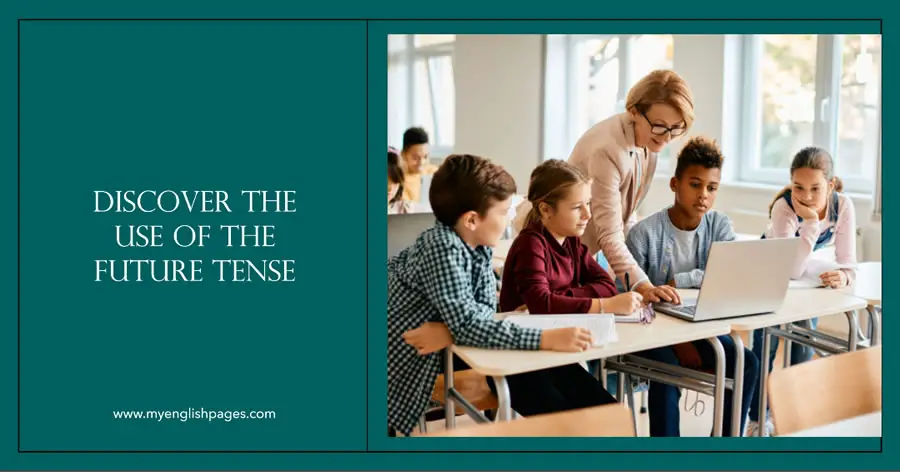Table of Contents
Introduction
Welcome to our grammar guide on the future tense! This page will explore how we talk about the future. Various structures that express the future will be covered.
What You’ll Learn:
Discover how we talk about future events using different tenses. We’ll cover:
- Present Tense for Scheduled Events.
- Future Plans and Arrangements.
- Simple Future Tense (will + verb).
- Future Progressive Tense.
- Future Perfect Tense.
- Future Perfect Progressive Tense.
- Modals for Future Uncertainties.
This table provides a clear and organized overview of the main points about each type of future tense we will be discussing, along with corresponding examples.
| Future Tense Type | Main Point | Examples |
|---|---|---|
| 1. Present Tense for Scheduled Events | The simple present tense is used for referring to scheduled future events. | – The train leaves at 6:00 in the morning. – The school year starts next week. – We arrive at 4:00 this afternoon. |
| 2. Future Plans and Arrangements | Express future plans and arrangements using either: | – Present continuous: We are leaving this morning at 7:00. – Simple present (to be) + going to + verb: I am going to meet him later. – Note: “Going to” is also used for predictions: Be careful! You are going to break the glass. |
| 3. Simple Future (will + verb) | The simple future is used in various situations: | – Prediction: It will rain tomorrow. – Instant Decision: A: “The Phone is ringing.” B: “I’ll answer it.” – Offers and Promises: I’ll call you tomorrow. I’ll help you with those boxes. – Conditional Clauses Type 1: “We will watch the match if we finish the work early.” |
| 4. Future Progressive Tense | The future progressive tense is used to describe ongoing actions that will be in progress at a specific point in the future. | – At this time tomorrow, I will be swimming in the ocean. – They will be renovating the house next month. |
| 5. Future Perfect Tense | The future perfect tense is used to describe actions that will be completed before a specified future point. | – By next year, she will have traveled to five different countries. – I will have completed my assignment by the time the deadline arrives. |
| 6. Future Perfect Progressive Tense | The future perfect progressive tense is used for ongoing actions that will be in progress and completed by a specific time in the future. | – In five years, they will have been working together for a decade. – By the end of the month, I will have been living in this city for two years. |
| 7. Modals for Uncertainty | Modals such as may, might, and could are used when we are not sure about the future. The modal “should” may express the likelihood that something in the future will happen. | – We might meet them in Paris. – I may go out this evening. – We should be there soon. |
Exploring the Future Tense:

Let’s now explore the various nuances of using the future tense in more detail:
1. Present Tense for Scheduled Events:
- The simple present tense is used for referring to scheduled future events.
- Examples:
- The train leaves at 6:00 in the morning.
- The school year starts next week.
- We arrive at 4:00 this afternoon.
- Examples:
2. Future Plans and Arrangements:
- Express future plans and arrangements using either:
- Present continuous
- Example: We are leaving this morning at 7:00.
- Simple present (to be) + going to + verb
- Example: I am going to meet him later.
- Note: “Going to” is also used for predictions.
- Example: Be careful! You are going to break the glass.
- Present continuous
3. Simple Future (will + verb):
- The simple future is used in various situations:
- Prediction: It will rain tomorrow.
- Instant Decision: A: “The Phone is ringing”. B: “I’ll answer it.”
- Offers and Promises. Here are some examples:
- I’ll call you tomorrow.
- I’ll help you with those boxes.
- Conditional Clauses Type 1: “We will watch the match if we finish the work early.”
4. Future Progressive Tense:
The future progressive tense is used to describe ongoing actions that will be in progress at a specific point in the future. This tense provides a sense of continuity and duration for actions anticipated down the line.
Examples:
- At this time tomorrow, I will be swimming in the ocean.
- They will be renovating the house next month.
5. Future Perfect Tense:
The future perfect tense is used to describe actions that will be completed before a specified future point. It conveys the idea that an action will be finished by a certain time in the future.
Examples:
- By next year, she will have traveled to five different countries.
- I will have completed my assignment by the time the deadline arrives.
6. Future Perfect Progressive Tense:
The future perfect progressive tense is used for ongoing actions that will be in progress and completed by a specific time in the future. This tense emphasizes both the duration and completion of the action.
Examples:
- In five years, they will have been working together for a decade.
- By the end of the month, I will have been living in this city for two years.
7. Modals for Uncertainty:
- Modals such as may, might, and could are used when we are not sure about the future:
- Examples:
- We might meet them in Paris.
- I may go out this evening.
- Examples:
- The modal verb “should” may also refer to the future, indicating a high likelihood that something will occur:
- Examples:
- We should be there by 10 am.
- They should arrive there soon.
- Examples:
Conclusion
Remember to use these structures appropriately based on the context of the conversation or writing. Mastering these future tense forms will enhance your ability to convey different shades of meaning when discussing future events.
Related Materials:


